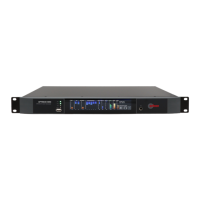2-2 Installation
Surge Protection
Always place surge protection circuits as close as possible to the 5950. AC power line surges should be handled in a
way that keeps instantaneous potential differences between the power line hot, neutral, AC grounding conductor,
the station ground and the processor chassis as low as possible. Likewise, measures should also be taken to keep
the instantaneous potential difference between the audio cable shields and the processor chassis as low as
possible (this applies to all audio equipment, not just the 5950), particularly when the equipment is located within
the electrically hostile environment of a station’s transmitter facility.
UPS/Power Conditioning
Choose the best power conditioning/UPS units that your budget will allow, focusing on the most important
features and options that you actually need. Some questions to ask while reviewing features are:
x How does the unit handle AC power that is not exactly 60Hz, such as when the facility is on its backup
generator?
x If the unit has onboard surge protection, what kind of surge capability does it have and where are those surges
directed to?
x Is the unit equipped with remote monitoring capability?
x Does it have onboard monitoring and alarms to signal a problem such as batteries with low reserve?
Where to locate the 5950
The best location for THE OPTIMOD-5950 is as close as possible to the transmitter, so that its stereo encoder
output can be connected to the transmitter through a circuit path that introduces the least possible change in the
shape of THE OPTIMOD-5950’s carefully peak-limited composite waveform—a short length of coaxial cable. If this
is impossible, the next best arrangement is to feed the 5950’s AES3 digital output through an all-digital,
uncompressed path to the transmitter's exciter, although this will preclude using the 5950’s composite limiter.
Use the 5950’s left and right analog audio outputs in situations where the stereo encoder and exciter are under
the jurisdiction of an independent transmission authority and where the programming agency’s jurisdiction ends at
the interface between the audio facility and the link connecting the audio facility to the transmitter. (The link
might be telephone / post lines, analog microwave radio, or various types of digital paths.) This situation is not
ideal because artifacts that cannot be controlled by the audio processor can be introduced by the link to the
transmitter, by transmitter peak limiters, or by the external stereo encoder.
If the transmitter is not accessible: All audio processing must be done at the studio and you must tolerate any
damage that occurs later.
If you can obtain a broadband (0-75 kHz) phase-linear link to the transmitter and the transmitter authority will
accept the delivery of a baseband encoded signal, use the 5950’s internal stereo encoder at the studio location to

